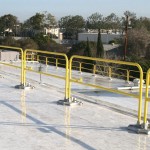What is the difference between passive and active fall protection?
 Active fall protection requires special equipment, participation and training on the part of the user (i.e., if the worker needs a harness, it is an “active” system). It is generally used in a situation where a worker requires a fall arrest system to arrest or stop their fall.Due to the nature of active fall protection, there is a potential for injury during and after a fall in the form of suspension trauma, and, therefore, a rescue plan is needed with every system of this type.
Active fall protection requires special equipment, participation and training on the part of the user (i.e., if the worker needs a harness, it is an “active” system). It is generally used in a situation where a worker requires a fall arrest system to arrest or stop their fall.Due to the nature of active fall protection, there is a potential for injury during and after a fall in the form of suspension trauma, and, therefore, a rescue plan is needed with every system of this type.
In contrast, passive, or collective, fall protection requires no special equipment, training or action on the part of a worker. The system is in place to either prevent the fall from occurring in the first place (such as with guardrails or other type of barrier system), or to catch the worker in the event of a fall (such as with the installation of properly designed safety netting hung below the work surface).
View All FAQs.

